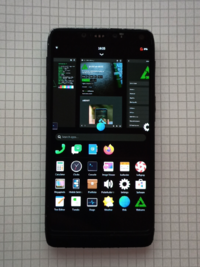Motorola RAZR i (XT890) (motorola-smi)
Appearance
 Motorola RAZR i running the Phosh UI | |
| Manufacturer | Motorola |
|---|---|
| Name | RAZR i |
| Codename | motorola-smi |
| Released | 2012 |
| Type | handset |
| Hardware | |
| Chipset | Intel Medfield Z2460 |
| CPU | Intel Atom Z2460 @ 2 GHz (single-Core) |
| GPU | PowerVR SGX 540 @ 400 MHz |
| Display | 4.3″(10.9cm) edge-to-edge qHD Super AMOLED Advanced touchscreen, 540×960 pixels (256 dpi), 16M colors |
| Storage | 8 GB flash memory |
| Memory | 1 GB RAM |
| Architecture | x86 |
| Software | |
Original software The software and version the device was shipped with. |
Android 4.4.2 |
Extended version The most recent supported version from the manufacturer. |
Android |
| postmarketOS | |
| Category | testing |
Mainline Instead of a Linux kernel fork, it is possible to run (Close to) Mainline. |
yes |
pmOS kernel The kernel version that runs on the device's port. |
6.2.7 |
| Device package |
|
| Kernel package |
|
Flashing Whether it is possible to flash the device with pmbootstrap flasher. |
Works
|
|---|---|
USB Networking After connecting the device with USB to your PC, you can connect to it via telnet (initramfs) or SSH (booted system). |
Works
|
Battery Whether charging and battery level reporting work. |
Partial
|
Screen Whether the display works; ideally with sleep mode and brightness control. |
Works
|
Touchscreen |
Works
|
| Multimedia | |
3D Acceleration |
Broken
|
Audio Audio playback, microphone, headset and buttons. |
Broken
|
Camera |
Broken
|
| Connectivity | |
WiFi |
Works
|
Bluetooth |
Broken
|
GPS |
Broken
|
NFC Near Field Communication |
Broken
|
| Modem | |
Calls |
Broken
|
SMS |
Broken
|
Mobile data |
Broken
|
| Miscellaneous | |
FDE Full disk encryption and unlocking with unl0kr. |
Works
|
| Sensors | |
Accelerometer Handles automatic screen rotation in many interfaces. |
Broken
|
Contributors
Users owning this device
How to enter flash mode
- Hold + buttons
- Release button as soon as device vibrates
Installation
- Bootloader must be unlocked
- Bootloader from Android 4.0 firmware doesn't support standard bootimg format. Bootloader from Android 4.1 firmware or later should work
- Installation with
pmbootstrap flashershould work.
Notes
GPU acceleration with the PowerVR SGX540 is not available, but the software based pixman renderer works quite well on the device's x86 CPU.
What works:
- booting pmOS with phosh
- installing applications
- browsing the web
- display brightness adjustment
- charging over USB
What doesn't
- CPU-freq / CPU-idle / Powemanagement
- Device runs in full power mode and drains battery quickly
Mainline
The internal peripherals of the Intel Medfield SoC can be discovered by PCI and mostly already work with the mainline kernel drivers.
Intel MID devices where designed to boot using Intel's "Simple Firmware Interface" (SFI). The mainline implementation of SFI was quite messy and has recently been dropped in newer releases. Therefore, the second stage bootloader Petitboot is used to boot newer kernels with kexec and devicetree.
See also
- pmaports!3774 Initial merge request (motorola-smi)
- Intel MID